Terry Blake's
Propeller Style
Asynchronous Rotary Spark Gap
(ARSG)The asynchronous rotary spark gap provides total control of the pulse rate into the Tesla coil. This has a tremendous effect on the character of the coil, and the amount of power that can be pumped into it. The operator can transform a big fuzz of wispy random arcs into a single, thick, mean,Viper of white hot plasma.
It is said that for a given power input, a synchronous rotary spark gap at 120 BPS will give the longest spark output. This is because the capacitor is given the longest time to charge, creating the greatest voltage and thus the maximum number of Joules into the primary circuit. While this is true, it assumes that the capacitor value is relatively large, so that it does not achieve as high a voltage at faster break rates. If the capacitor was chosen so that it could achieve full charge in 1/2 the time, then a break rate of 240 BPS would generate pulses of the same magnitude as the 120 BPS, but there would be 2X as many pulses per unit of time. In theory, that should translate to the same number of Joules per unit of time, since Energy = 1/2 CV^2. We cut the C in half, but doubled the number of energy pulses. This assumes that the charge current is fixed (often true), and that the voltage V is always the same (the V^2 can cause a lot of confusion if we let it). If someone knows why this logic is flawed, please let me know.
So maybe we can say that the capacitor can be reduced in value to allow for faster break rates or conversely we can say that the current into the capacitor can be increased to take advantage of higher break rates. Both of these are valid conclusions, and have merit. This is because the capacitors for Tesla coil use tend to be expensive, and bigger means more $$. So it is a concern. Another issue not often considered is that a given Tesla coil can take only so large of an energy pulse before the secondary starts to arc over into destruction. This is bad. Because of this limitation, we cannot keep cranking up capacitor so we can crank up the power. At some point we have to back off or burn up the coil. However, we can continue to increase the rate of sub-damaging pulses for quite a while, thus putting more total power into the coil than could have with the 120 BPS SRSG.
Let's face it, the Tesla coil is really cool, but after a while, it does tend to lose some of the luster. People get really excited the first time they see one, but most people get bored after a while. The ARSG adds another dimension of excitement to the TC, in that it controls and changes it's character (visual and sound). The lower break rates create many random arcs can become a big electrical fuzz. They are plenty cool and scary. But as the pulse rate goes up, the time since the last arc goes down, and the ions from the discharge contribute more and more to the path that the next discharge takes. The total number of individual arcs continues to drop until there appears to be only 1. Every new arc follows the same general path as the previous arc. This makes the one arc thicker and whiter than the individual arcs could achieve by themselves, and allows the total arc length to grow farther than might otherwise be possible.
So the ARSG allows us to use a smaller capacitor than we would otherwise
need (saves money), and allows us to pump more power into a Tesla coil
than we could have with the 120 BPS SRSG.
I am not sure what the disadvantages of the ARSG are, but I'll work
on it.
Low Inertia Rotor
(9 inch diameter)
The spinning rotor can require substantial power (translates to bigger motor) to get up to a given speed. The larger the disk becomes, the more power is required from the motor. This ARSG has 8 stationary electrodes (3/16" rod), hooked up in 2 sets of 4, and a single 9" rotating electrode (equivalent to 2 electrodes spaced 180 degrees on a 10" disk) that makes contact 8 times per revolution. The rotor is automatically in balance if it is centered. This low-inertia design allows the use of a very small AC/DC motor. It is often called a "propeller gap".
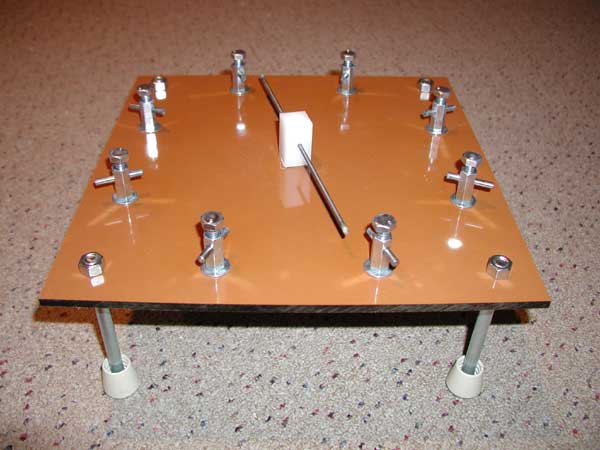
The base is a 12 inch square phenolic plate (1/4 inch thick).
The legs are bolts with some little rubber feet. The electrode holders
are 1/4 inch couplings for threaded rod.

There are a total of 8 stationary electrodes, for 8 alignments / revolution.
A break rate of 480 BPS requires a speed of 3600 RPM. 480 BPS is plenty.
I would not push the speed much beyond that.

The electrodes are inter-connected with brass strips to create the
two sides of the switch. The maze of scrawls used to map out where the
holes should go is clear on the bottom.
The motor is an AMETEK AC/DC 19,500 RPM motor from Grainger http://www.grainger.com
(#4M979 $28.60).
There is a similar motor from American Science and Surplus http://www.sciplus.com/
, is called a universal ball bearing vacuum cleaner motor.
120 V, AC/DC, 15,000 rpm, 30599 VACUUM MOTOR $7.50

Free-standing rubber feet keep it from moving around too much.
Motor is just above the ground.
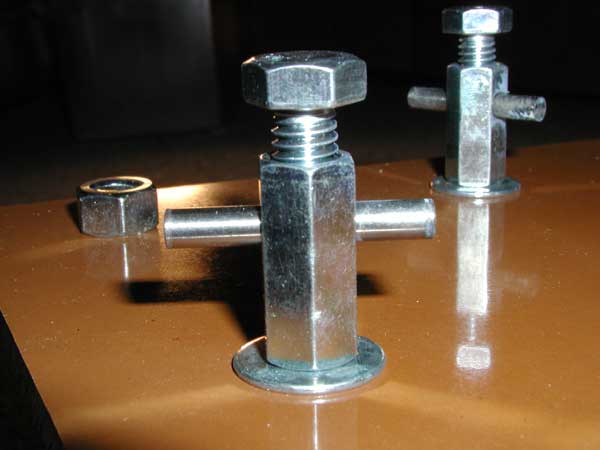
The 1/4 inch couplings are drilled with a 3/16 inch hole for holding
the electrodes. The electrodes are 1.25 inch lengths of pure Tungsten
rod (3/16 " thick). The bolt holds the rod in place.
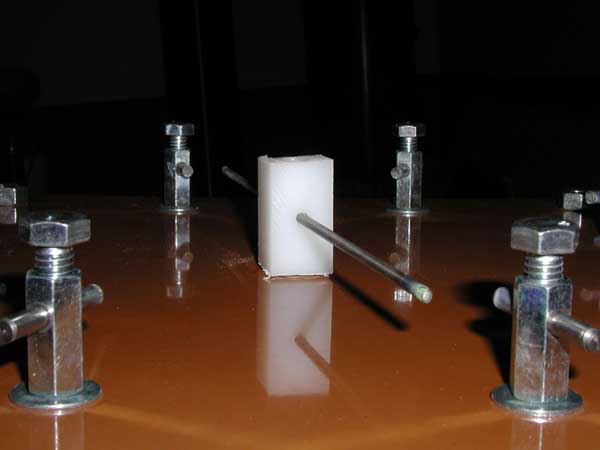
The low inertia rotor is made up of a single 9" Tungsten welding electrode
(1/8" thick) and a 3/4" square length of polyethylene. The 9" electrode
is press fit into the poly' to make the rotor, and that is press fit onto
the motor shaft. Somehow it all stays together with no set screws.
The rotor can be slid up and down to align with the stationary electrodes.
The rotating electrode can be slid back and forth to get it perfectly centered,
and thus perfectly balanced..
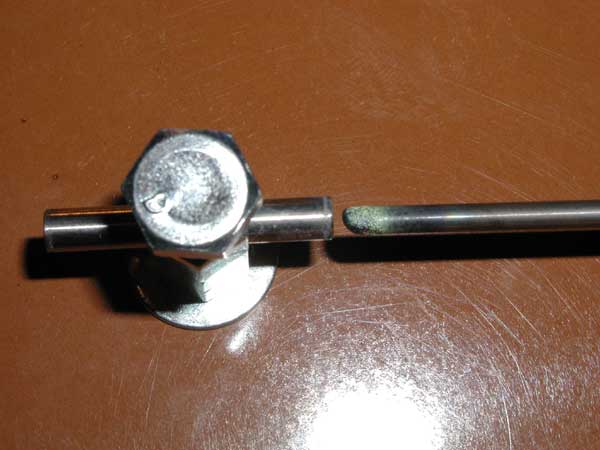
The stationary electrodes can be adjusted for alignment and gap.
Typically the gap is kept as small as possible. After about 10 minutes
of 5,000W operation, the stationary electrodes show virtually no wear.
But the rotor electrode is clearly getting cooked. I'll have to get
something thicker.
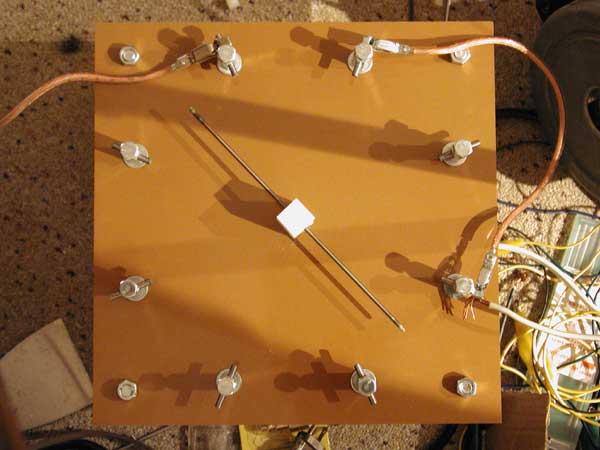
I didn't feel like making dedicated contacts for this gap, so the connection
is made by clamping onto the electrodes. Extra contacts can be made
to ensure a really good connection.

Here is the ARSG in operation (about 500 W). The main light
source is the spark itself, creating the illusion that there are 8 spinning
electrodes. This convincing illusion is not just camera trickery.
It really looks like this. Cool. If you get close to a speed
that is synchronous with the AC wave form, you can see dark areas rotating
around where the zero crossing is.